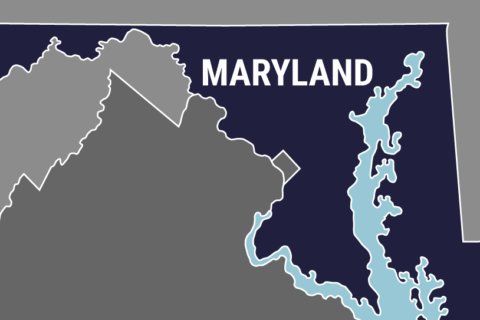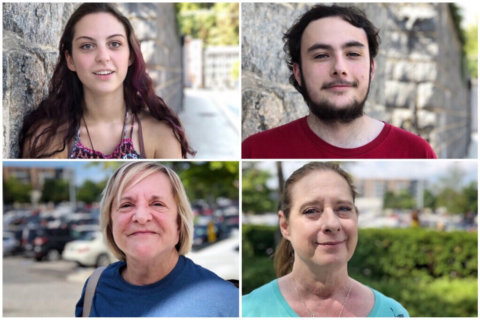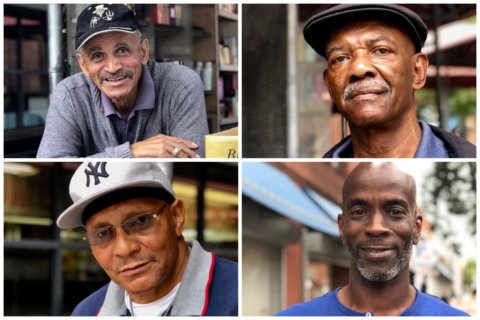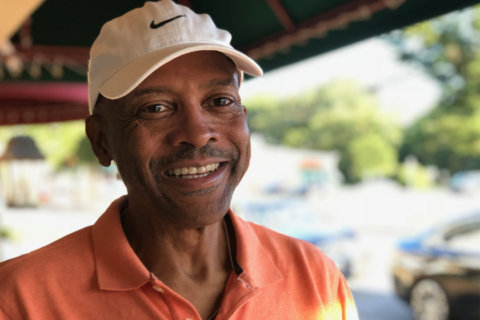This article was republished with permission from WTOP’s news partners at Maryland Matters. Sign up for Maryland Matters’ free email subscription today.
By Bruce DePuyt — When Gov. Lawrence J. Hogan Jr. (R) announced a major plan to widen three Maryland roadways last year, even transportation insiders were caught off-guard.
“I was surprised by it, but I rejoiced at it,” said John B. Townsend II, AAA mid-Atlantic’s manager of public and government affairs.
“As much as people are loath to admit it, the congestion in Maryland has limited economic development in the state. And [it has] impacted the quality of life because of the amount of hours — more than 80 hours a year [on average] — we spend being stuck in traffic.”
The $9 billion plan for a public-private partnership, which Hogan unveiled in 2017, would add four lanes each to Interstate 270, the Capital Beltway (I-495) in Montgomery and Prince George’s counties, and the Baltimore-Washington Parkway. The three roads bog down regularly, and not just at rush hour, because they carry much more traffic than they were designed for.
The new lanes would be “express toll” lanes, similar to those built in recent years on I-95 north of Baltimore City, where motorists can decide whether to drive them if they are willing to pay tolls that fluctuate based on traffic volume.
“It’s been literally decades that there have been studies on how to address the problem of I-270 and 495,” said Maryland Transportation Secretary Pete K. Rahn in an interview. “It’s always been concluded that there are not enough resources available to fix the problem.
“That’s what makes what we are doing with the traffic relief plan different. We have a way to actually put something in place that’s going to make it better for those hundreds of thousands of commuters that are on those routes every day.”
In his first term as governor, Hogan:
— gave final approval to build and broke ground on the long-planned Purple Line, a light rail system running from New Carrollton, through the University of Maryland, to Bethesda;
— brokered a deal with Virginia and Washington, D.C., to provide WMATA, the capital region’s subway and bus system, the first dedicated source of funding in its 40-year history;
— killed plans for the proposed Red Line, a light rail project, in Baltimore City;
— reduced some bridge tolls and eliminated the monthly fee for EZ Pass transponders;
— finished construction of the new Dover Bridge along MD 331 over the Choptank River, early and under budget; and
— allocated $2 billion to rehabilitate, replace or begin construction work on all 69 structurally deficient bridges identified during his first year in office.
“We will continue to focus on a balanced transportation system, which means addressing highways and transit and pedestrian and bicycle and also even innovative transportation modes,” Rahn said.
Red Line Still Rankles
Hogan’s Democratic challenger Benjamin T. Jealous (D) has accused the administration of failing to enact a coherent plan for connecting people with worksites and universities.
“Maryland does not have a forward-thinking vision for how it’s going to plan for growing populations in our cities,” said Jealous’ spokeswoman, Jerusalem Demsas.
The decision to ax the Red Line, a light rail line that would have run from the Center for Medicare and Medicaid Services in Woodlawn to the Johns Hopkins Bayview campus, means “we don’t have proper mass transit in the state’s largest city,” Demsas said.
“The Red Line, a decadelong project pushed forward by [former U.S. Sen.] Barbara Mikulski and other state leaders, was canceled single-handedly by Larry Hogan and replaced with a bus system that has failed on every metric to meet the needs of Baltimore City residents.”
Demsas said the plan to widen the three highways is “an election-year gimmick” and “not a long-term solution.”
“If you just increase the number of lanes in a highway, people will just fill up the highway again,” she said.
She further charged that residents of the less-populated portions of the state are also suffering due to Maryland’s transportation failures.
“What we’re seeing on the Eastern Shore is that people who are well-educated, people that are doing well, just leave because it’s impossible to connect the jobs in the major cities that we have out there.”
If elected, Demsas said, Jealous would:
— find a “real solution to the lack of mass transit in the Baltimore region”;
— add bus rapid transit service to the state’s four most populous subdivisions; and
— engage residents in determining what transportation solutions they need to get to work and school.
“Ben’s entire plan for transportation is to make sure that we’re connecting people to the jobs that exist now and we’re also planning for what’s going to happen in the future.”
A recent The Washington Post/University of Maryland poll found that opposition to the Hogan road-widening plan outpaces support, even in the Washington region, which routinely ranks as having some of the worst congestion in the nation.
The survey found that 54 percent of voters in Prince George’s and Montgomery counties opposed the Hogan plan, while 41 percent supported it.
Opposition was fairly consistent across the political spectrum and various demographic groups. Support was strongest among younger voters surveyed and the more affluent.
News reports from Virginia, which now has an extensive network of high-occupancy toll lanes, is likely the reason the public is skeptical about the Hogan plan, observers said, particularly in the I-66 corridor, where tolls can reach eye-popping levels.
“What’s embedded in people’s heads are those $45 tolls,” said AAA’s Townsend.
The Virginia Department of Transportation “blew it, and that, I think, was damaging — and it could even damage the effort to transform Maryland 295, transform the Beltway … and also 270,” he said. “Because people loathe tolls.”
Rahn, Maryland’s transportation secretary, said residents should look north, not south, to get a true feel for how HOT lane tolls would function on the BW Parkway, I-495 and I-270.
“That’s a unique circumstance to … that section of I-66,” he said. “I have no expectations whatsoever that we would see the kinds of tolls that we are seeing in the news for I-66.”
A Pledge to Preserve Houses
Hogan has pledged that no homes will be taken to make way for the three road-widening projects, a claim that Demsas, the Jealous spokeswoman, called “not credible.”
Ben Ross, head of the Maryland Transit Opportunities Coalition, said the projects are certain to cost more than advertised — and he too doubts the state can add lanes without the use of eminent domain.
“They took $100 million a mile, which is the cost of building roads out in the countryside but not when you’re in a built-up area,” he said, adding, “If they want to stay within the existing right of way, they have to double-deck [the highway], and that would drive up the costs astronomically.
“How do you build it in that narrow right of way without shutting down the highway for a year?”
An analysis that Ross conducted concluded that motorists would have to pay $41 just go get from Frederick to Shady Grove Road in Montgomery County. “And that’s assuming they filled up the road with cars — and at that price they can’t fill up the road. So it will still need a state subsidy.”
Ross said it was notable that Jealous brought up the subject of Hogan’s road plan during the gubernatorial debate, but the governor did not.
Rahn expressed confidence that engineers will be able to come up with a design that expands capacity without taking existing homes.
“This is not the first roadway that is tight and needs to have some additional lanes. This has occurred around the country and around the world.”
He pointed to the LBJ Freeway in Dallas as an example of how solutions to seemingly intractable challenges can be found.
“They were dealing with an even more constrained right of way than we are on 495. They have a roadway that is cantilevered below what was the existing level. So they did additional lanes into the roadway and it is actually functioning incredibly well.”
Even Townsend, a supporter of additional road capacity, expressed concern that there will not be enough land to widen the B-W Parkway, which is currently owned by U.S. Department of the Interior. Hogan’s plan for the B-W Parkway relies on the federal government turning the land over to the state.
“I cannot see that one in my head,” Townsend said. “I’ve been to the town hall meetings. I still don’t know how you do it without eminent domain, which is always bothersome to me.”
If houses and businesses do need to be taken, Townsend said it’s “imperative” that owners be compensated fairly.
“The government has to give the great priority to making those people whole. We’re not talking about a token kind of payment. I’ve seen too many people lose their treasure and their investment because of these takings. It is an unfortunate thing … It [has to be] more than just market value.”
Critics often refer to HOT lanes as “Lexus lanes” because the tolls are theoretically less of a challenge to high income motorists. But supporters call them a win-win.
“Even if you don’t want to pay [to drive] in an express toll lane, you’re going to benefit by the fact that there are people using those versus the lanes that you’re already in,” Rahn said.
Townsend said Virginia’s early experiences with HOT lanes, on I-395, convinced him that the “Lexus lane” label was unfair.
“Everybody benefited, including those people that didn’t pay, because it took enough traffic off the existing lanes … The commute time dropped for everyone. That is something that none of us foresaw. That’s when I became a believer in the concept.”
Townsend said there are benefits to infrastructure improvements that don’t often get talked about, including reduced deaths and injuries, and an increased ability to evacuate people in an emergency.
He called the Hogan plan “a game-changer.”
“We are behind the eight ball in terms of competing in the regional economy … and the national economy. … I think the next governor, the next General Assembly session, will have to do more than just pay lip service to freeing up space on the existing highway system and reducing commuter traffic on local roads.”
Roads Improving
Maryland’s State Highway administrator, Gregory I. Slater, said the Hogan administration has made great strides in maintaining existing roads and bridges over the last four years.
“Eighty-eight percent of our [road] system has an acceptable ride quality, and 85 percent of our system has ‘preferred’ maintenance system — that means all of the assets of that system are in great shape,” he said.
In addition, Slater said, the state is being more diligent about upkeep, so fewer structures reach the crisis point, noting that “97.6 percent of our bridges are in fair or better condition. That means we have one of the lowest percentages of structurally deficient bridges in the entire nation.”
Kevin Quinn, head of the Maryland Transit Administration, said the state has spent $800 million on new rail cars for the Baltimore Metro system, to be rolled out in the next few years; “a full rehab of 53 light rail cars … that’s going to give a new face to our light rail”; and a “locked-in” contract on replacement buses that will carry the state through fiscal year 2024.
He also said the agency is embracing technology to improve commuters’ experience, including a new system to relay “real-time information to our customers” and a mobile-ticketing app that “includes a free transfer window, which essentially puts money back into the pocket of Marylanders.
“It’s a real exciting time for MTA here in Maryland,” he said.
Rahn pointed to the expansion of MD 404 on the Eastern Shore, “which was a deadly roadway,” the groundbreaking on MD 219 in Western Maryland, and the record-setting performance of state-owned BWI Airport and the Port of Baltimore as other transportation accomplishments of the last four years.
“We’re going to continue to be making investments to support and drive our economy.”
Rahn said Washington Redskins fans are getting out of the stadium parking lots 15-20 percent more quickly thanks to “a smart-signal program to adjust traffic timing on the fly.”
According to one longtime Hogan administration critic, the governor is able to tout significant progress on transportation projects in large part because his predecessor, former Gov. Martin J. O’Malley Jr. (D), pushed an increase to the gasoline tax through the General Assembly.
“He shows up at every one of these ribbon-cuttings and ground-breakings and talks about how ‘the state is finally putting money into roads and the bridges,’ said state Sen. Richard S. Madaleno Jr. (D-Montgomery), who ran in this year’s gubernatorial primary.
Hogan defeated O’Malley’s lieutenant governor, Anthony G. Brown, in 2014, in large part because he pounded the Democrats on their willingness to raise taxes.
“It’s because of the tax increase that, if [he] had had his way, would never have occurred,” Madaleno said.
Killing the Red Line and a shift in financing for the Purple Line (putting it on “the credit card,” in Madaleno’s view), also helped free up cash for numerous other projects.
The gas tax “was a plan that no Republican [legislator] voted for, even though the business community, the Maryland Chamber [of Commerce], the [Greater Washington] Board of Trade, all these interests, were consistently asking us to do this,” said Madaleno, outgoing vice chairman of the Senate Budget and Taxation Committee.
Among the issues likely to dominate the next four years — regardless of who is governor — is whether the state should build a new Chesapeake Bay crossing.
Ross, the transit advocate, said the issue has “gone under the radar at the state level.”
A study is underway now. Of the three basic concepts being considered — building next to the existing spans, or one from Dundalk to Kent County, or one in Southern Maryland — all would be likely to generate opposition.
AAA’s Townsend said Maryland’s modern history is to spend decades fighting over every project that comes along, citing the Intercounty Connector highway and the Purple Line as examples.
“The investment in infrastructure, the investment in transportation, has accrued to the benefit of Virginia but not to Maryland,” he said, “because we have never seen it as a priority.”
“You can be anti-growth if you wish, but then you lag behind. That’s why this gubernatorial race is so important. It is: What do we do about infrastructure?”









